Abstract
This study presents a practical framework for the maximal covering location problem (MCLP) under uncertainty. The approach combines possibility theory with chance-constrained programming to represent both imprecision and randomness in demand. Demand is modeled as fuzzy random variables. Using the Zadeh extension principle, both the fuzzy and fuzzy random formulations are transformed into equivalent deterministic mixed-integer programs. Clear linearization steps are provided for the objective function and constraints. Two specifications are examined to reflect different attitudes toward risk. The first specification uses possibility measures, reflecting an optimistic stance, while the second uses necessity measures and represents a conservative approach. Computational experiments conducted in an urban facility context show that increasing the possibility or probability level results in more conservative solutions and a smaller amount of covered demand. In contrast, lower thresholds lead to more exhaustive coverage with greater exposure to uncertainty. In the deterministic scenario, full coverage becomes attainable as the number of facilities increases. Under uncertainty, the models balance coverage with robustness based on the chosen risk tolerance levels. The proposed framework serves as a flexible decision support tool, enabling planners to align facility location choices with their risk tolerance while maintaining tractability with standard optimization solvers.
Keywords:
maximal covering location problem; facility location; fuzzy stochastic programming; possibility theory MSC:
90B80; 90C11; 90C15; 03E72
1. Introduction
In private facility locations, firms pursue measurable performance goals, most notably reducing total costs and increasing access to target markets. Because these objectives can be quantified, mathematical programming provides a sound and transparent basis for selecting locations that advance strategic aims. Public facility location presents a different challenge. Objectives such as equity, adequate service, and social welfare do not lend themselves easily to direct measurement, leading to the use of surrogate measures as a practical alternative to facilitate analysis. Two surrogates are most common. The first is the total weighted travel distance or time between demand points and facility locations. The second is the maximum distance or time required for any user to be served, generally known as the maximal service distance; this represents the system’s worst performance and is well documented in the regional planning literature for emergency services such as fire and ambulance coverage []. When resources are limited and cannot meet all demand points within the target distance, the decision becomes whether to prioritize universal coverage or strategically place a certain number of facilities to serve the largest possible share of demand. This consideration introduces a crucial point of interest for policymakers: the population served within an acceptable distance. Formulated in this way, the problem is to select facility locations that maximize the population within a defined service distance, subject to a facility budget constraint. This is the maximal covering location problem, whose aim is to provide service to the greatest feasible proportion of the population within the specified travel limit, as initially formulated in [].
In situations where public agencies or private companies provide services to more than one community, the maximal covering location problem (MCLP) is used to determine the placement of a defined number of facilities such that as much demand as possible is served. Because its structure closely correlates with actual decisions in emergency response, public service provision, and network design, MCLP has motivated significant research on methods for solving its computational problems. In a covering model, a facility is considered to serve a customer if the travel distance or time between the customer and the facility is not greater than some prescribed threshold value, usually known as the coverage radius or coverage distance []. This threshold determines the effective range of a facility and enables the model to identify which demand points can be allocated to a facility. The challenge, therefore, is to choose facility locations within a fixed facility budget that maximize the number of demand points served within a specified radius.
This paper presents a new solution framework for the maximal covering location problem under uncertainty by combining possibility theory with fuzzy random chance-constrained programming. The central idea is to convert the original fuzzy random optimization model into an equivalent deterministic linear program. We achieve this by applying Zadeh’s extension principle [] to propagate imprecision and by using possibility- and necessity-based chance constraints to reflect the decision-makers’ risk attitudes, yielding formulations suited to both optimistic and conservative preferences [].
The remainder of the paper is structured as follows. Section 2 reviews key studies on the maximal covering location problem. Section 3 summarizes essential ideas from fuzzy set theory and fuzzy random theory. Section 4 formulates the maximal covering location problems (MCLPs) under uncertainty and presents the solution approaches. We then convert these formulations into deterministic models using possibility theory and fuzzy random chance-constrained programming. Section 5 reports computational results and includes an illustrative example to clarify the procedure. Section 6 concludes and outlines directions for future research.
2. Literature Review
In recent decades, the MCLP has become a central topic in operations research, tackling facility location optimization challenges. Originating in the mid-20th century, the problem became popular as a solution to the growing need for efficient resource allocation in many industries. Today, MCLP is studied due to its ongoing relevance in addressing real-world problems, advancements in optimization methodologies, and its potential to inform decision-making processes in various industries [].
In recent years, researchers have advanced solution strategies for the maximal covering location problem across diverse settings. A genetic algorithm enhanced with local refinement improved solution quality []. A genetic algorithm with local search was designed to address a bilevel MCLP heuristically, which is formulated as a bilevel mathematical program []. Two evolutionary procedures, one based on a genetic algorithm and the other on discrete differential evolution, were proposed for the weighted anti-covering location problem, a closely related formulation []. Seeking tighter optimality gaps than typical genetic algorithms, the MCLP was recast as a Markov decision process, and a deep reinforcement learning method, Deep MCLP, was introduced []. For contexts with imprecise data, a fuzzy capacitated MCLP with fuzzy coverage degrees and fuzzy customer distances was solved using a hybrid population-based algorithm []. The modeling scope was broadened with a general framework for multi-type MCLP [,,,,]. Finally, a multi-period facility–location model was introduced that maximizes coverage while enforcing a coverage–reliability constraint [].
Decision-making in practice often relies on incomplete or noisy information; thus, location models must handle uncertainty. Two mature approaches are stochastic programming and fuzzy programming. Recent studies show how these ideas extend the maximal covering location problem. All inputs were treated as imprecise, and the problem was framed in a fuzzy setting, yielding a set of non-dominated fuzzy solutions []. Both the facility coverage radius and customer-to-facility distances were modeled as fuzzy, and finite capacity was imposed at each site, leading to a capacitated model with a fuzzy coverage area []. An uncertain maximal covering model was developed to locate smart recycling facilities, with service cost modeled as an uncertain parameter []. Reflecting operational realities, ambulance siting was analyzed to improve coverage for rare and random road crashes []. Extending to network reliability, reliability computation was studied for a probabilistic location set covering problem in wireless networks with equal-reliability servers covering moving cells in the service region [].
Some researchers have generalized the maximal covering location problem to more realistic requirements. A robust stochastic model was proposed to site artesian wells in order to alleviate drought under uncertainty []. The minimum covering location problem was generalized by incorporating gradual coverage with distance-dependent decay, yielding a gradual minimum covering location problem with explicit distance constraints []. Their formulation captures the practical decline of service quality with distance rather than a hard cutoff. A hybrid covering location model that combines set covering and maximal covering was also introduced, enabling planners to guarantee a minimum service level while expanding coverage when resources permit []. Taken together, these contributions illustrate how the traditional framework can be adapted to uncertainty, distance-sensitive service, and mixed policy objectives.
Past efforts to solve the maximal covering location problem have often overlooked demand uncertainty. To address this gap, we consider fuzzy programming and stochastic programming simultaneously for uncertain demand. This paper develops new solution methods for the MCLP in which the parameters are modeled as fuzzy random variables, while the decision variables remain real. The approach integrates possibility theory [], Zadeh’s extension principle [], and fuzzy random chance-constrained programming (FRCCP) []. Koç and Sarıkaya [] use the maximal covering method in determining distribution centers in disaster logistics. Recently, a bi-objective mathematical model for a maximal covering hub location problem was presented to minimize time and environmental risks []. Furthermore, the Maximum Coverage Model and Recommendation System for UAV Vertiports Location Planning is introduced by Chunliang et al. [].
Our objective is to bridge the divide between deterministic and uncertainty-aware decision-making. We first provide a brief overview of fuzzy numbers, then formulate the problem in deterministic, fuzzy, and fuzzy random forms. A case study is conducted to demonstrate the effectiveness of the proposed methods using both deterministic and uncertain demand data, followed by a thorough analysis of the results.
3. Basic Concepts
In this section, key concepts related to fuzzy numbers are summarized, drawing on [,]. A fuzzy set on the real line is regarded as a fuzzy number when it is normal, convex, upper semicontinuous, and has compact support. These structural conditions clarify the behavior of fuzzy numbers and support their use in fuzzy logic and other mathematical applications. The LR fuzzy number, introduced by Dubois and Prade, is a widely used special case [,]. The following membership function defines the LR fuzzy number A:
where denotes the peak of the fuzzy number, with and representing the lower and upper bounds of this interval. represent the left and right spreads, respectively. The functions L and R are defined as L, R: with the properties and , ensuring they are strictly decreasing, continuous functions. A possible representation of an LR fuzzy number is .
The concept of a fuzzy random variable (FRV), as defined by Puri and Ralescu, refers to a random variable whose realizations are fuzzy numbers. Specifically, an FRV is a Borel-measurable mapping from a probability space to the space of fuzzy numbers []. In essence, an FRV integrates randomness and fuzziness into a single mathematical construct, providing a flexible framework for modeling and analyzing uncertainty in diverse applications, including decision-making, control systems, and optimization, where considering both probabilistic and fuzzy aspects is essential.
4. Problem Definition
The maximal covering location problem (MCLP), introduced by Church and ReVelle [], is an optimization framework used in facility location analysis. Its primary objective is to maximize the demand within a specified service distance S while considering a limited number of new facility sites. The MCLP is particularly useful when resources are constrained and full coverage of all demand points is unattainable. It supports decision-makers in selecting facility locations that maximize overall service coverage within the available resources.
In practice, most decisions are made under uncertainty. To address this, researchers have developed methods such as stochastic programming and fuzzy programming over the past two decades. Recent advances show that both fuzzy linear programming and fuzzy random linear programming (FRLP) can be reformulated as deterministic linear programs by using chance-constrained techniques []. In these approaches, an extended form of chance constrained programming (CCP) employs possibility and necessity measures to represent fuzzy stochastic constraints in FRLP models. This reformulation enables a solution with standard linear optimization tools while preserving the original uncertainty through adjustable confidence levels, allowing analysts to adopt more conservative or more optimistic decision stances as needed.
4.1. Model Formulation
4.1.1. Deterministic Model
To formulate this problem, we use the following notation, as shown in Table 1:

Table 1.
Nomenclature.
Table 1 provides an overview of the nomenclature used in this research, including indices, parameters, and decision variables. The table below offers clear guidance on the mathematical formulation of the MCLP
Thus, MCLP can be formulated as follows:
The objective function (2) aims to maximize the number of covered demand nodes. Constraint (3) defines the relationship between the coverage and location variables, indicating that node i is covered if at least one facility is located at a potential site capable of covering node i. Constraint (4) limits the number of facilities located to P. Constraints (5) and (6) serve as internality constraints.
4.1.2. Fuzzy Maximal Covering Location Problem (FMCLP)
We intend to add fuzziness to the MCLP model. For this, the demand coefficients of the objective function will be considered as fuzzy numbers:
where represents an LR fuzzy variable involved in the objective function.
4.1.3. Possibility and Necessity-Based Model
In this section, fuzzy chance-constrained programming is used to transform the fuzzy linear program into an equivalent deterministic linear program. The reformulation relies on possibility and necessity measures and yields an equivalent deterministic model, as shown in [].
Since the original formulation is not fully specified and imprecise, a lower objective value conservative bound is added. The optimization then maximizes this lower bound. In the case of constraints where coefficient values are fuzzy numbers, the level of satisfaction is realized by their degrees of possibility or necessity. The levels manage the conservatism of the solution and provide a practical linear program that expresses the structure of uncertainty in a transparent manner.
Each coefficient is a fuzzy number. Therefore, by Zadeh’s extension principle, the objective function is also a fuzzy number, whose membership function is defined as follows:
where
By using the extension principle of Zadeh, the degree of possibility for the fuzzy constraint based on the possibility distribution is defined as follows:
Let be the permissible possibility level. We maximize lower bound variable and apply the possibility measure to handle fuzzy numbers in the objective function of fuzzy programming by the following model:
4.1.4. Possibility-Based Model
The optimal solution of this possibility-based model is called the P-Optimal solution of FMCLP. We should reformulate to transform the above model into a deterministic model. In order to transform the above model into a deterministic one, we obtain the following theorem. This linearization proceeds along the CCP-based approach documented for fuzzy LPs []:
Theorem 1.
Let be a non-negative decision vector, then
where pseudo-inverse functions are defined as .
For more study about this theorem and for its proof, the reader can be referred to the recent study [] about the fuzzy random programming method.
The optimal solution of the fuzzy model is equivalently obtained by the following problem:
By employing this deterministic reformulation with real-valued parameters, we derive P optimal (possibility-based) solutions for the original fuzzy maximal covering location problem. The resulting linear program is then solved with standard linear programming software.
4.1.5. Necessity-Based Model
The possibility-based model often generates optimistic solutions, which may not be suitable for decision-makers who are risk-averse and prefer more conservative options. In these situations, a necessity-based model is more appropriate, as it focuses on ensuring constraints and minimizing the risk of adverse outcomes.
By using the extension principle of Zadeh, the degree of necessity for the fuzzy constraint based on the possibility distribution is determined as follows:
Like the possibility case, the lower bound variable is maximized, and the necessity measure is applied to handle fuzzy numbers in the objective function of problem 1 by the following model:
The optimal solution of this model is referred to as the N-optimal solution of the FMCLP. To convert this model into a linear constraint, we obtain the following Theorem 2:
Theorem 2.
Let x be a non-negative decision vector, then
where is the pseudo-inverse function of L defined as .
The optimal solution of the necessity-based fuzzy model is equal to the optimal solution of the following problem:
The model described above is an example of a deterministic LP problem [].
4.2. Fuzzy Random Maximal Covering Location Problem (FRMCLP)
In practical optimization, many parameters are uncertain. Two well-established approaches address this challenge: stochastic programming, which treats unknowns as random variables with specified distributions, and fuzzy programming, which represents imprecision through membership functions and possibility measures. When both randomness and vagueness are present, a combined framework is required. Fuzzy stochastic programming integrates probability and possibility to capture these two facets of uncertainty at the same time. A key variant is FRVs, which uses FRVs to model cases where the realized values of random parameters are themselves fuzzy numbers. In such models, uncertainty is described with both probabilistic and possibilistic information, and outcomes are represented as fuzzy sets. In summary, fuzzy programming handles imprecision, stochastic programming handles randomness, and the combined methods offer a unified way to manage both.
Maximal covering location problem with FRVs:
The MCLP with FRV coefficients is formulated as follows:
where represents FRV, whose observed value for each is a fuzzy number , respectively. Furthermore and are random variables defined as in which is a random variable with expected value and the cumulative distribution function , respectively. Reference [] presented this definition of random variables.
In this section, the FRMCLP model is transformed into a deterministic model using fuzzy random CCP, which is based on possibility, necessity measures, along with Zadeh’s extension principle. Our reformulation of the FRMCLP adopts the same CCP-based deterministic transformation that is adapted to fuzzy random coefficients []. To effectively manage FRVs in the FRMCLP P model, we define the following programming model by applying fuzzy random CCP based on possibility measures:
where is the permissible probability level and is the permissible possibility level.
We need to reformulate the relationship between the constraint and possibility measures into proper forms. By applying Theorem 1, Theorem 3 is obtained to convert the final model into a deterministic problem.
Theorem 3.
Let be a non-negative decision vector, then
where is a pseudo-inverse function defined as
Using Theorem 3 of basic concepts, the problem is equivalently reformulated as follows:
When we use necessity measures for pessimistic decision-makers, the following programming model is defined as the MCLP with :
Now, we utilize Theorem 2 to reformulate relationships between constraints with necessity measures. This approach leads to the following Theorem 4.
Theorem 4.
Let be a non-negative decision vector, then
Finally, the programming model of FRMCLP for pessimistic decision-makers is equivalently transformed into the following deterministic problem:
5. Case Study
We have utilized MCLP to plan a limited number of shopping centers in a context where we lack sufficient funds and facilities. This constraint prevents us from building enough shopping centers to meet all the demands. As a result, we intend to cover as many demands as possible within the designated area. To achieve this goal, we have divided a relatively large area of the city into specific demand regions. By establishing the origin of coordinates, we have assigned coordinates for each of the demand regions. In each of the regions, we collected data on demand and calculated the average. This data accounts for both certainty and uncertainty. To determine the optimal locations for our facilities, we will solve MCLP, fuzzy MCLP, and fuzzy random MCLP to address the problem.
All computations were performed on a Dell computer with a 2.5 GHz CPU Core 2 Duo and 3 GB RAM. The software used for coding and calculations is GAMS Ver.24.1.2. Furthermore, we have assumed the maximal covering distance of 1.5 km.
5.1. The Case Study Data in Certainty
The coordinates of 20 areas in the city of Tabriz with a demand for shopping centers have been identified and are listed in Table 2. The corresponding demand values are presented in Table 3, while the potential locations for establishing shopping centers have also been determined. Potential locations for establishing shopping centers, along with their coordinates, are presented in Table 4. These locations aim to meet the shopping center demands of the 20 identified areas.

Table 2.
Coordinates of demand nodes in specific areas in Tabriz.

Table 3.
Demand value of each node.

Table 4.
Coordinates of potential locations of facilities.
Table 2 presents the locations of 20 demand nodes in specific areas of Tabriz that indicate a demand for shopping centers. These locations highlight the importance of strategically placing facilities to effectively serve as many people as possible. Additionally, the provided data is useful in optimizing the model.
Table 3 shows the demand values for each node, highlighting the importance of prioritizing facility placement by focusing on nodes with higher demand to improve coverage.
Table 4 presents nine potential locations for establishing shopping centers. These spots have been selected based on feasibility factors and their ability to fulfill customers’ needs. The distribution of these potential locations spans a wide geographical area, providing a wide coverage and assisting in choosing the best locations for constructing the centers.
5.2. Computational Results with Deterministic Parameters
Our goal is to identify the minimum number of facilities required to cover all demands. To accomplish this, we apply the basic MCLP model, based on the provided data. We will analyze various numbers of facilities to determine how many are necessary to cover all demands. The findings are summarized in Table 5, which shows the coverage of demand nodes by a single facility.

Table 5.
Demand nodes covered by one facility.
Regarding the coordinates of the facility located at (x = 2.7, y = 4.1), as indicated in Table 5, constructing a single facility will partially meet the demand while leaving other nodes uncovered. Figure 1 illustrates the facility’s location, distinguishing between covered and uncovered demand nodes. It highlights the established facility and identifies potential locations for additional centers.
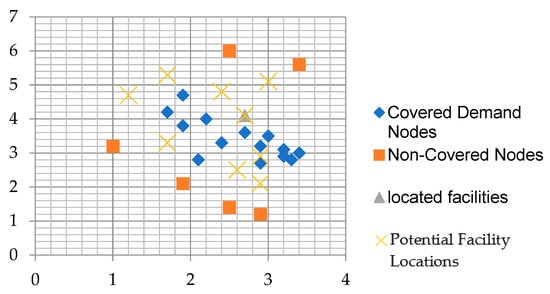
Figure 1.
The location of covered and non-covered demand nodes and one located facility.
Table 6 and Figure 2 present the results of constructing two facilities that cover the demand nodes, illustrating how the selected locations collectively fulfill the service requirements and optimize coverage throughout the network.

Table 6.
Demand nodes covered by constructing two facilities.
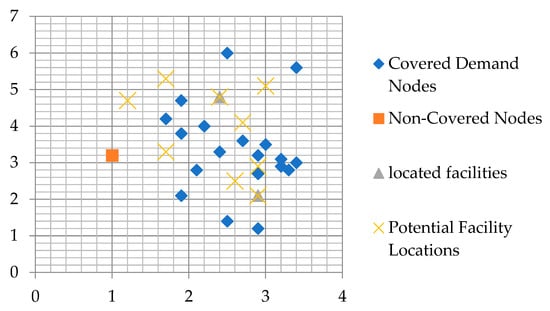
Figure 2.
The location of covered and non-covered demand nodes and two facilities.
Table 6 displays the results of allocating two facilities at the coordinates (x = 2.9, y = 2.1) and (x = 2.4, y = 4.8), demonstrating an increase in the covered area. Figure 2 illustrates the location of these two facilities, showing both the nodes that are covered and those that remain uncovered. Notably, the number of uncovered areas has decreased due to this expansion; however, some regions still lack coverage.
The results of establishing three facilities to cover the demand nodes efficiently are comprehensively presented in Table 7 and Figure 3, illustrating their impact on overall service coverage and resource allocation.

Table 7.
Demand nodes covered by constructing three facilities.
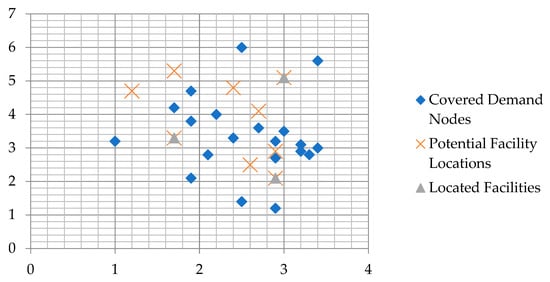
Figure 3.
The location of covered demand nodes and three facilities.
Table 7 shows the results of the deterministic model when three facilities are allocated at (x = 2.9, y = 2.1), (x = 3, y = 5.1), and (x = 1.7, y = 3.3). This setup achieves comprehensive coverage of all 20 demand nodes, satisfying a total need of 4060. Hence, Figure 3 graphically illustrates the locations of the three facilities and their corresponding coverage, showing how allocating these three facilities effectively eliminates gaps and ensures coverage of all nodes.
5.3. Computational Results with Fuzzy and Fuzzy Stochastic Programming
First, fuzzy programming optimization is used for the problem under a fuzzy framework. Next, fuzzy stochastic programming is applied to address the problem under both fuzziness and randomness.
The uncertainty parameters in real-world decision-making require us to incorporate both fuzziness and randomness, which we refer to as fuzzy stochastic programming optimization.
5.3.1. Computational Results with Fuzzy Demand Parameter
In this section, the demand values are represented as fuzzy numbers, as illustrated in Table 8. The fuzzy data has been developed based on the original data, supplemented by input from experts and feedback collected through questionnaires, as summarized in Table 8. Additionally, possibility levels of 0.1, 0.3, 0.5, 0.7, and 0.9 have been considered.

Table 8.
Fuzzy parameters of the case study.
The computation results of fuzzy programming for different possibility levels in both a possibility-based model and a necessity-based model for establishing three facilities to cover the demand nodes are listed in Table 9.

Table 9.
Numerical results of the case study with fuzzy parameters for establishing three facilities to cover the demand nodes.
Table 9 presents the computation results of fuzzy programming for different possibility levels in both the possibility-based and necessity-based models, which aim to establish three facilities to cover the demand nodes.
The results, particularly illustrated in Figure 4 and Table 9, indicate that as the possibility level increases, the number of covered demands decreases in both the possibility and necessity models. This trend indicates that at higher possibility levels, the optimization of the objective function is affected, resulting in a reduction in covered demands. Furthermore, the covered demand in the possibility-based model is greater than that in the necessity-based model.
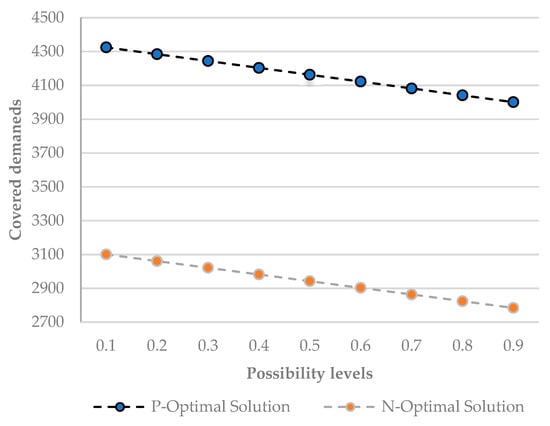
Figure 4.
Coverage of the demands of the case study through fuzzy programming in establishing three facilities.
5.3.2. Computational Results with Fuzzy Random Demand Parameters
In real-world applications, uncertain parameters often exhibit both fuzzy and stochastic characteristics, leading to their modeling as fuzzy random variables. These variables are derived from the original data through expert consultations and questionnaire analyses. They are summarized in Table 10 as FRVs and represented as ordered quadruples where is a normal random variable with and . The FRV parameters related to the demand coefficient in the objective function for 20 nodes are provided in Table 10, considering uncertainty, which includes base demand values, spreads, and stochastic elements.

Table 10.
Fuzzy random parameters in the case study.
Table 11 and Table 12 present the results of the fuzzy stochastic programming computations for different possibility and probability levels in the possibility-based and necessity-based models, respectively. The aim of these results is to establish three facilities to cover the demand at the specified nodes.

Table 11.
Numerical results of the case study through fuzzy stochastic programming, possibility-based model.

Table 12.
Numerical results of the case study through fuzzy stochastic programming, necessity-based model.
The findings in Table 11 demonstrate the impact of possibility (η) and probability (θ) levels on the extent of coverage. Increasing either θ or η results in reduced overall demand coverage.
Table 12 presents the results of the necessity-based model under fuzzy random conditions. Like the possibility-based model, as the levels of θ and η increase, the covered demand decreases. The results from the necessity-based model are generally lower than those from the possibility-based model, highlighting the cautious approach that characterizes necessity-based decision-making.
Figure 5 and Figure 6 provide an alternative viewpoint to Table 11 and Table 12, illustrating the optimistic and pessimistic scenarios, respectively. Figure 5 and Figure 6 and Table 11 and Table 12 show the optimal solutions of the problem at different levels of probability and possibility, but the DM can choose a proper level based on his/her circumstances or any other constraints. In both instances, the results clearly indicate that when the probability level remains constant, an increase in the possibility level leads to a decrease in total covered demand. Likewise, when the possibility level remains steady, raising the probability level also results in a reduction in total covered demand.
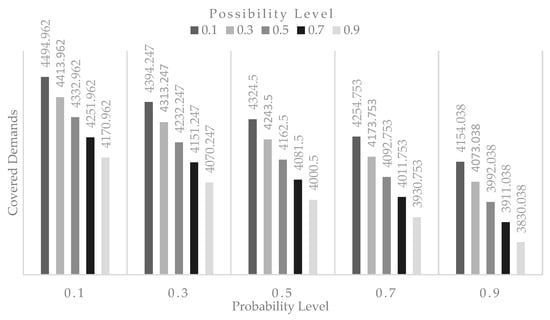
Figure 5.
The optimal covered demands of the case study through fuzzy stochastic programming with a possibility-based model.
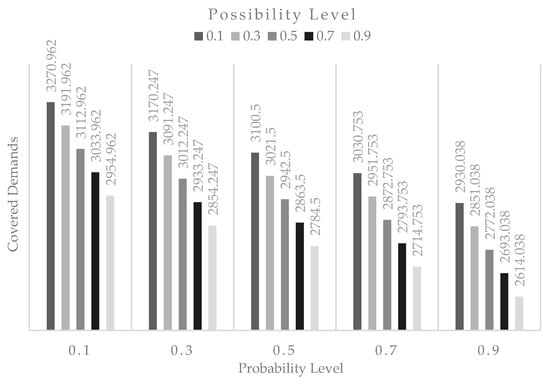
Figure 6.
The optimal covered demands of the case study through fuzzy stochastic programming with a necessity-based model.
In the optimistic possibility-based model, the total covered demand is higher compared to the pessimistic necessity-based model. However, in both optimistic and pessimistic scenarios, total covered demand has an inverse relationship with both possibility and probability levels.
6. Conclusions
By analyzing our computational results alongside the number of facilities we can construct, we can identify the most suitable locations to meet maximum demand. This information simplifies the decision-making process for stakeholders when choosing the best locations from a range of potential sites. Furthermore, due to the uncertainty inherent in real-world decision-making, we employed various approaches, including fuzzy programming, fuzzy stochastic programming, possibility-based models, and necessity-based models. This variety allowed us to evaluate the differences in covered demands across these models. Additionally, our findings revealed that as we increase the levels of possibility and probability, the number of demands covered tends to decrease. Based on these conditions, by selecting an appropriate solution model, P-optimal for optimistic decision-makers and N-optimal for pessimistic decision-makers, and choosing suitable values for the possibility and probability levels, we can approximate the number of demands covered by the current location of facilities.
Author Contributions
Conceptualization, J.N., S.G. and P.S.S.; methodology, P.S.S. and D.K.; software, J.N. and S.G.; validation, P.S.S., D.K. and P.B.; formal analysis, P.S.S., D.K. and P.B.; investigation, P.S.S., S.G. and D.K.; resources, J.N.; data curation, J.N. and D.K.; writing—original draft preparation, J.N., S.G. and P.S.S.; writing—review and editing, P.S.S., P.B. and D.K.; visualization, J.N.; supervision, S.G. and P.S.S.; project administration, S.G., P.B. and D.K.; funding acquisition, D.K. and P.B. All authors have read and agreed to the published version of the manuscript.
Funding
This research received no external funding.
Data Availability Statement
The original contributions presented in this study are included in the article. Further inquiries can be directed to corresponding authors.
Acknowledgments
Predrag Stanimirović is supported by the Ministry of Science, Technological Development and Innovations, Republic of Serbia, grant number 451-03-137/2025-03/200124. Predrag Stanimirović is supported by the Ministry of Science and Technology of China under grant H20240841.
Conflicts of Interest
The authors declare no conflicts of interest.
References
- Church, R.; ReVelle, C. The Maximal Covering Location Problem. Pap. Reg. Sci. 1974, 32, 101–118. [Google Scholar] [CrossRef]
- Fallah, H.; Naimi-Sadigh, A.; Aslanzadeh, M. Covering Problem. In Facility Location; Physica-Verlag HD: Heidelberg, Germany, 2009; pp. 145–176. [Google Scholar]
- Dubois, D.; Prade, H. Possibility Theory, Probability Theory and Multiple-Valued Logics: A Clarification. Ann. Math. Artif. Intell. 2001, 32, 35–66. [Google Scholar] [CrossRef]
- Zadeh, L.A. The Concept of a Linguistic Variable and Its Application to Approximate Reasoning—I. Inf. Sci. 1975, 8, 199–249. [Google Scholar] [CrossRef]
- Atta, S.; Mahapatra, P.R.S.; Mukhopadhyay, A. Solving Maximal Covering Location Problem Using Genetic Algorithm with Local Refinement. Soft Comput. 2018, 22, 3891–3906. [Google Scholar] [CrossRef]
- Casas-Ramírez, M.-S.; Camacho-Vallejo, J.-F.; Díaz, J.A.; Luna, D.E. A Bi-Level Maximal Covering Location Problem. Oper. Res. 2020, 20, 827–855. [Google Scholar] [CrossRef]
- Chappidi, E.; Singh, A. Evolutionary Approaches for the Weighted Anti-Covering Location Problem. Evol. Intell. 2023, 16, 891–901. [Google Scholar] [CrossRef]
- Wang, S.; Liang, H.; Zhong, Y.; Zhang, X.; Su, C. DeepMCLP: Solving the MCLP with Deep Reinforcement Learning for Urban Facility Location Analytics. Mathematics 2023, 11, 4567. [Google Scholar]
- Aider, M.; Dey, I.; Hifi, M. A Hybrid Population-Based Algorithm for Solving the Fuzzy Capacitated Maximal Covering Location Problem. Comput. Ind. Eng. 2023, 177, 108982. [Google Scholar] [CrossRef]
- Blanco, V.; Gázquez, R.; Saldanha-da-Gama, F. Multi-Type Maximal Covering Location Problems: Hybridizing Discrete and Continuous Problems. Eur. J. Oper. Res. 2023, 307, 1040–1054. [Google Scholar] [CrossRef]
- Chauhan, R.; Unnikrishnan, A.; Figliozzi, M.A.; Boyles, S.D. Robust Multi-Period Maximum Coverage Drone Facility Location Problem Considering Coverage Reliability. Transp. Res. Rec. 2023, 2677, 98–114. [Google Scholar] [CrossRef]
- Arana-Jiménez, M.; Blanco, V.; Fernández, E. On the Fuzzy Maximal Covering Location Problem. Eur. J. Oper. Res. 2020, 283, 692–705. [Google Scholar] [CrossRef]
- Atta, S.; Mahapatra, P.R.S.; Mukhopadhyay, A. Solving a New Variant of the Capacitated Maximal Covering Location Problem with Fuzzy Coverage Area Using Metaheuristic Approaches. Comput. Ind. Eng. 2022, 170, 108315. [Google Scholar] [CrossRef]
- Wang, Z.; Duan, Y.; Huo, J. Maximal Covering Location Problem of Smart Recycling Infrastructure for Recyclable Waste in an Uncertain Environment. Waste Manag. Res. 2021, 39, 396–404. [Google Scholar] [CrossRef]
- Mohri, S.S.; Haghshenas, H. An Ambulance Location Problem for Covering Inherently Rare and Random Road Crashes. Comput. Ind. Eng. 2021, 151, 106937. [Google Scholar] [CrossRef]
- Feng, Z.; Okamura, H.; Dohi, T.; Yun, W.Y. Reliability Computing Methods of Probabilistic Location Set Covering Problem Considering Wireless Network Applications. IEEE Trans. Reliab. 2023, 72, 1234–1245. [Google Scholar] [CrossRef]
- da Cunha Nunes, D.R.; da Silva Júnior, O.S.; de Mello Bandeira, R.A.; Vieira, Y.E.M. A Robust Stochastic Programming Model for the Well Location Problem: The Case of the Brazilian Northeast Region. Sustainability 2023, 15, 10916. [Google Scholar] [CrossRef]
- Khatami, M.; Salehipour, A. The Gradual Minimum Covering Location Problem. J. Oper. Res. Soc. 2023, 74, 1092–1104. [Google Scholar] [CrossRef]
- Alizadeh, R.; Nishi, T. Hybrid Set Covering and Dynamic Modular Covering Location Problem: Application to an Emergency Humanitarian Logistics Problem. Appl. Sci. 2020, 10, 7110. [Google Scholar] [CrossRef]
- Nematian, J. A Fuzzy Robust Linear Programming Problem with Hybrid Variables. Int. J. Ind. Syst. Eng. 2015, 19, 515–546. [Google Scholar] [CrossRef]
- Koç, M.; Sarıkaya, H.A. Maximal covering method in determining distribution centers in disaster logistics. End. Mühendisliği 2024, 35, 22–60. [Google Scholar] [CrossRef]
- Khalilzadeh, M.; Ahmadi, M.; Kebriyaii, O. A Bi-Objective Mathematical Programming Model for a Maximal Covering Hub Location Problem Under Uncertainty. SAGE Open 2025, 15, 21582440251324335. [Google Scholar] [CrossRef]
- Hua, C.; Hu, X.; Sun, J.; Yang, Z. The Maximum Coverage Model and Recommendation System for UAV Vertiports Location Planning. arXiv 2025, arXiv:2508.12651. [Google Scholar] [CrossRef]
- Puri, M.L.; Ralescu, D.A. Differentials of Fuzzy Functions. J. Math. Anal. Appl. 1983, 91, 552–558. [Google Scholar] [CrossRef]
- Katagiri, H.; Kato, K.; Hasuike, T. A Random Fuzzy Minimum Spanning Tree Problem through a Possibility-Based Value at Risk Model. Expert Syst. Appl. 2012, 39, 10639–10646. [Google Scholar] [CrossRef]
- Dubois, D.; Prade, H. Fuzzy Real Algebra: Some Results. Fuzzy Sets Syst. 1979, 2, 327–348. [Google Scholar] [CrossRef]
- Dubois, D.; Prade, H. On Fuzzy Syllogisms. Comput. Intell. 1988, 4, 171–179. [Google Scholar] [CrossRef]
- Katagiri, H.; Sakawa, M.; Kato, K.; Nishizaki, I. Interactive Multiobjective Fuzzy Random Linear Programming: Maximization of Possibility and Probability. Eur. J. Oper. Res. 2008, 188, 530–543. [Google Scholar] [CrossRef]
Disclaimer/Publisher’s Note: The statements, opinions and data contained in all publications are solely those of the individual author(s) and contributor(s) and not of MDPI and/or the editor(s). MDPI and/or the editor(s) disclaim responsibility for any injury to people or property resulting from any ideas, methods, instructions or products referred to in the content. |
© 2025 by the authors. Licensee MDPI, Basel, Switzerland. This article is an open access article distributed under the terms and conditions of the Creative Commons Attribution (CC BY) license (https://creativecommons.org/licenses/by/4.0/).